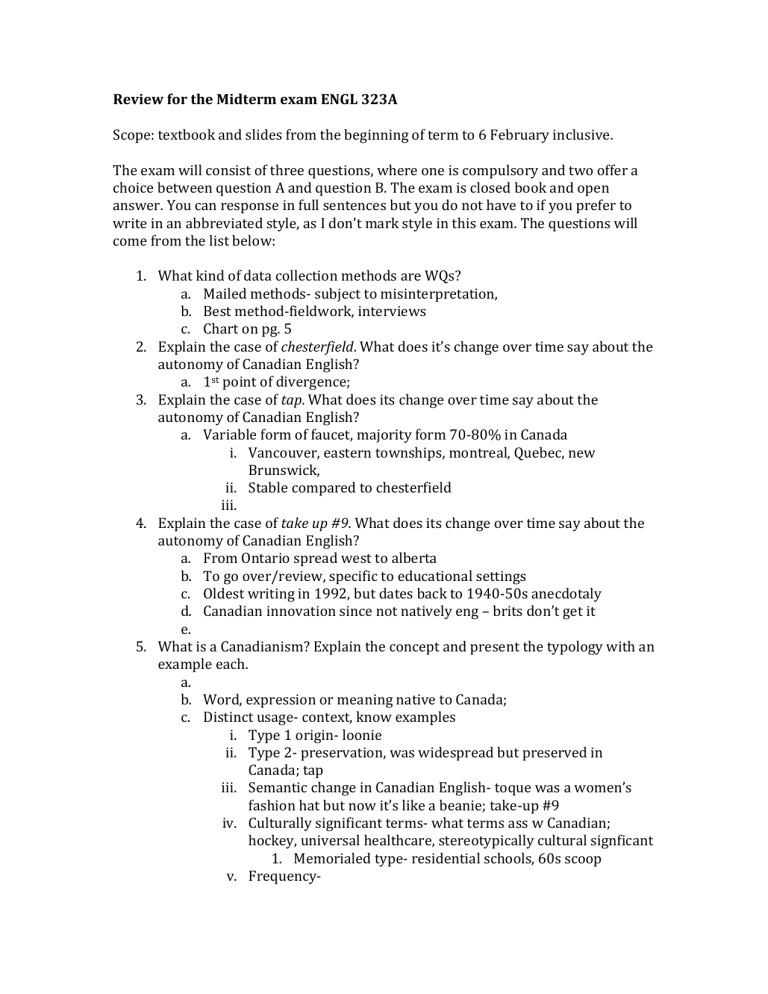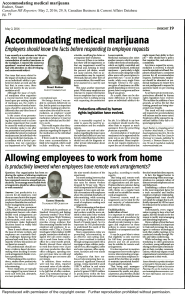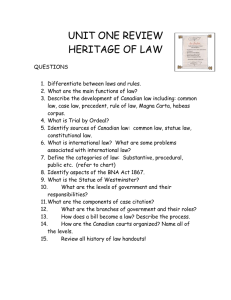
Review for the Midterm exam ENGL 323A Scope: textbook and slides from the beginning of term to 6 February inclusive. The exam will consist of three questions, where one is compulsory and two offer a choice between question A and question B. The exam is closed book and open answer. You can response in full sentences but you do not have to if you prefer to write in an abbreviated style, as I don’t mark style in this exam. The questions will come from the list below: 1. What kind of data collection methods are WQs? a. Mailed methods- subject to misinterpretation, b. Best method-fieldwork, interviews c. Chart on pg. 5 2. Explain the case of chesterfield. What does it’s change over time say about the autonomy of Canadian English? a. 1st point of divergence; 3. Explain the case of tap. What does its change over time say about the autonomy of Canadian English? a. Variable form of faucet, majority form 70-80% in Canada i. Vancouver, eastern townships, montreal, Quebec, new Brunswick, ii. Stable compared to chesterfield iii. 4. Explain the case of take up #9. What does its change over time say about the autonomy of Canadian English? a. From Ontario spread west to alberta b. To go over/review, specific to educational settings c. Oldest writing in 1992, but dates back to 1940-50s anecdotaly d. Canadian innovation since not natively eng – brits don’t get it e. 5. What is a Canadianism? Explain the concept and present the typology with an example each. a. b. Word, expression or meaning native to Canada; c. Distinct usage- context, know examples i. Type 1 origin- loonie ii. Type 2- preservation, was widespread but preserved in Canada; tap iii. Semantic change in Canadian English- toque was a women’s fashion hat but now it’s like a beanie; take-up #9 iv. Culturally significant terms- what terms ass w Canadian; hockey, universal healthcare, stereotypically cultural signficant 1. Memorialed type- residential schools, 60s scoop v. Frequency- 6. Illustrate the distribution and change over time of the variable different from/than/to. Is it a change from above or below and why? a. Change from below 7. Illustrate the distribution and change over time of the variable between you and me/I. Is it a change from above or below and why? a. Prescriptive form- and me; 20% still say you and I b. Change from above c. Pg 115 8. There have been changes in telling time in North America. Explain them and take a stance to the opinion that the invention of digital watches was responsible for the switch. a. Predates the shift to digital a century before the 70s b. Pg 119 9. What is apparent-time, what is real-time? How do they relate to the s-curve of linguistic change? Explain with an example. a. Apparent-uses age b. Realc. Assumes ling doesn’t change, if it does it’s an age graded change (zed) 10. Discuss gender effects in language, placing emphasis on Labov’s three principles. a. Deficitb. Different- men and women use diff c. Female linguistic superiority- women are more ling superior 11. Homogeneity in Canadian English: sociolinguists have often considered it a primary “active force” on the variety. Is this correct? a. 6.8 12. Autonomy in Canadian English: in the 1990s, sociolinguists predicted the demise of Canadian English as a variety. Comment on this opinion in an informed manner. a. 6.5 13. Settlement waves in Canada: explain them and relate briefly their influence on the making of Canadian English. a. 6.6 14. Theory of indexicalization: explain the approach in relation to yod in student. a. 6.7 and figure 6.12 15. Contrast Schneider’s and Trudgill’s models of the development of postcolonial Englishes. Where do the models agree, where are they different? a. 6.62, identity, wider model, no predictions- trudgill has stages no identity all mechanics 16. Language attitudes and perceptions: how can they be studied and why does such information matter to linguists? a. 7.3.4 and 7.3.5



